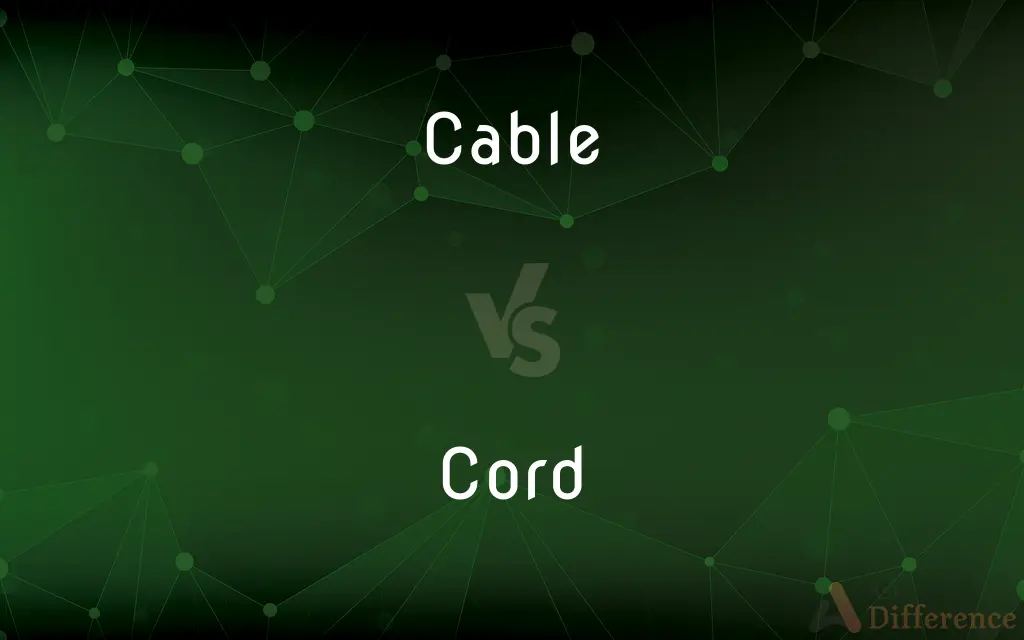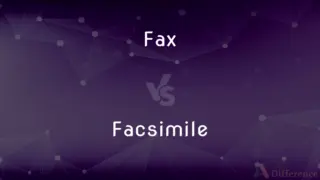Cable vs. Cord — What's the Difference?
By Tayyaba Rehman — Updated on October 5, 2023
A cable is a thick, heavy rope or insulated wire, while a cord is a thin, flexible strand or rope. E.g., "The cable supports the bridge." vs. "The cord binds the package."

Difference Between Cable and Cord
Table of Contents
ADVERTISEMENT
Key Differences
A cable, typically recognized as a substantial and often insulated wire, is principally used for transmitting power or data. Conversely, a cord, slender and more pliable, is widely associated with tying, binding, or connecting in various scenarios, presenting a contrast in form and function.
Notably, cables frequently become part of infrastructural and technological contexts, providing strength, connection, and transfer in constructions and networks. Cords, maintaining a distinct identity, are generally utilized in domestic or everyday applications, offering functionality and simplicity.
Cables in their sturdy and robust nature are oftentimes visible in construction sites, supporting structures like bridges, or facilitating transmission in technological apparatus. Whereas, cords, bring about images of accessibility and lightweight usage, such as in clothing, parcels, or low-power appliances.
In electrical contexts, cables are likely to be associated with the provision of power, data transmission, or heavy-duty applications given their protective insulation and capacity. Cords tend to be found in lighter, more versatile applications, exemplifying adaptability and user-friendliness in numerous environments.
Undeniably, cable and cord, while sometimes used interchangeably in common language, remain distinct in their core meanings and applications, underpinning specific and diverse utility in various fields, from construction, technology, to domestic usage, providing both support and connection.
ADVERTISEMENT
Comparison Chart
Basic Meaning
A thick, insulated wire
A thin, flexible strand
Part of Speech
Noun
Noun
Example Usage
Ethernet cables connect PCs.
She tied the box with a cord.
Common Associations
Data, power, strength
Binding, connecting, light use
Physical Characteristics
Generally thicker
Generally thinner
Compare with Definitions
Cable
A telegram, especially one sent abroad.
He received a Cable from his family overseas.
Cord
A thin rope made from twisting several strands together.
She used a Cord to tie the package.
Cable
A strong, large-diameter, heavy steel or fiber rope.
Cord
The umbilical cord, connecting a fetus to the placenta.
The doctor carefully cut the baby's Cord after birth.
Cable
Something that resembles such steel or fiber rope.
Cord
A slender length of flexible material usually made of twisted strands or fibers and used to bind, tie, connect, or support. See Usage Note at chord1.
Cable
(Electricity) A bound or sheathed group of mutually insulated conductors.
Cord
An insulated flexible electric wire fitted with a plug or plugs.
Cable
A sheathed bundle of optical fibers.
Cord
A hangman's rope.
Cable
A heavy rope or chain for mooring or anchoring a ship.
Cord
An influence, feeling, or force that binds or restrains; a bond or tie.
Cable
A cable length.
Cord
Also chord(Anatomy)A long ropelike structure, such as a nerve or tendon
A spinal cord.
Cable
Cable television.
Cord
A raised rib on the surface of cloth.
Cable
A similar service providing internet access.
Cord
A fabric or cloth with such ribs.
Cable
A cablegram.
Cord
Cords Pants made of corduroy.
Cable
Of or relating to a subscription television or internet service that uses cables to carry signals between local distribution antennas and the subscriber's location.
Cord
A unit of quantity for cut fuel wood, equal to a stack measuring 4 × 4 × 8 feet or 128 cubic feet (3.62 cubic meters).
Cable
To send a cablegram to.
Cord
To fasten or bind with a cord
Corded the stack of old newspapers and placed them in the recycling bin.
Cable
To transmit (a message) by telegraph.
Cord
To furnish with a cord.
Cable
To supply or fasten with a cable or cables.
Cord
To pile (wood) in cords.
Cable
To send a cablegram.
Cord
A long, thin, flexible length of twisted yarns (strands) of fiber (rope, for example); uncountable such a length of twisted strands considered as a commodity.
The burglar tied up the victim with a cord.
He looped some cord around his fingers.
Cable
(material) A long object used to make a physical connection.
Cord
A small flexible electrical conductor composed of wires insulated separately or in bundles and assembled together usually with an outer cover; the electrical cord of a lamp, sweeper (US vacuum cleaner), or other appliance.
Cable
A strong, large-diameter wire or rope, or something resembling such a rope.
Cord
A unit of measurement for firewood, equal to 128 cubic feet (4 × 4 × 8 feet), composed of logs and/or split logs four feet long and none over eight inches diameter. It is usually seen as a stack four feet high by eight feet long.
Cable
An assembly of two or more cable-laid ropes.
Cord
(figuratively) Any influence by which persons are caught, held, or drawn, as if by a cord.
Cable
An assembly of two or more wires, used for electrical power or data circuits; one or more and/or the whole may be insulated.
Cord
(anatomy) Any structure having the appearance of a cord, especially a tendon or nerve.
Spermatic cord; spinal cord; umbilical cord; vocal cords
Cable
(nautical) A strong rope or chain used to moor or anchor a ship.
Cord
Dated form of chord: musical sense.
Cable
(communications) A system for transmitting television or Internet services over a network of coaxial or fibreoptic cables.
I tried to watch the movie last night but my cable was out.
Cord
To furnish with cords
Cable
(TV) cable television, broadcast over the above network, not by antenna.
Cord
To tie or fasten with cords
Cable
A telegram, notably when sent by (submarine) telegraph cable.
Cord
To flatten a book during binding
Cable
(nautical) A unit of length equal to one tenth of a nautical mile.
Cord
To arrange (wood, etc.) in a pile for measurement by the cord.
Cable
100 fathoms, 600 imperial feet, approximately 185 m.
Cord
A string, or small rope, composed of several strands twisted together.
Cable
(finance) The currency pair British Pound against United States Dollar.
Cord
A solid measure, equivalent to 128 cubic feet; a pile of wood, or other coarse material, eight feet long, four feet high, and four feet broad; - originally measured with a cord or line.
Cable
(architecture) A moulding, shaft of a column, or any other member of convex, rounded section, made to resemble the spiral twist of a rope.
Cord
Fig.: Any moral influence by which persons are caught, held, or drawn, as if by a cord; an enticement; as, the cords of the wicked; the cords of sin; the cords of vanity.
The knots that tangle human creeds,The wounding cords that bind and strainThe heart until it bleeds.
Cable
(knitting) A textural pattern achieved by passing groups of stitches over one another.
Cord
Any structure having the appearance of a cord, esp. a tendon or a nerve. See under Spermatic, Spinal, Umbilical, Vocal.
Cable
(transitive) To provide with cable(s)
Cord
See Chord.
Cable
(transitive) To fasten (as if) with cable(s)
Cord
To bind with a cord; to fasten with cords; to connect with cords; to ornament or finish with a cord or cords, as a garment.
Cable
(transitive) To wrap wires to form a cable
Cord
To arrange (wood, etc.) in a pile for measurement by the cord.
Cable
(transitive) To send a telegram, news, etc., by cable
Cord
A line made of twisted fibers or threads;
The bundle was tied with a cord
Cable
(intransitive) To communicate by cable
Cord
A unit of amount of wood cut for burning; 128 cubic feet
Cable
To ornament with cabling.
Cord
A light insulated conductor for household use
Cable
(knitting) To create cable stitches.
Cord
A cut pile fabric with vertical ribs; usually made of cotton
Cable
A large, strong rope or chain, of considerable length, used to retain a vessel at anchor, and for other purposes. It is made of hemp, of steel wire, or of iron links.
Cord
Stack in cords;
Cord firewood
Cable
A rope of steel wire, or copper wire, usually covered with some protecting or insulating substance; as, the cable of a suspension bridge; a telegraphic cable.
Cord
Bind or tie with a cord
Cable
A molding, shaft of a column, or any other member of convex, rounded section, made to resemble the spiral twist of a rope; - called also cable molding.
Cord
A flexible insulated cable used to connect electrical devices.
The lamp's Cord was frayed and needed replacing.
Cable
To fasten with a cable.
Cord
A measure of volume for stacked firewood, equal to 128 cubic feet.
He bought two Cords of wood for the winter.
Cable
To ornament with cabling. See Cabling.
Cable
To telegraph by a submarine cable
Cable
A telegram sent abroad
Cable
A conductor for transmitting electrical or optical signals or electric power
Cable
A very strong thick rope made of twisted hemp or steel wire
Cable
A nautical unit of depth
Cable
Television that is transmitted over cable directly to the receiver
Cable
A television system transmitted over cables
Cable
Send cables, wires, or telegrams
Cable
Fasten with a cable;
Cable trees
Cable
A thick, strong rope made of intertwined strands.
The ship was anchored using a heavy-duty Cable.
Cable
A set of wires, covered by plastic, that carries electricity, phone signals, or internet connections.
The technician fixed the Cable to restore our internet.
Cable
A system of broadcasting television programs via transmitted signals.
We subscribed to a new Cable service to get more channels.
Cable
A unit of distance used in marine navigation, roughly equal to 1/10th of a nautical mile.
The ship was anchored five Cables from shore.
Common Curiosities
Can “cable” refer to a large, strong rope?
Yes, “cable” can refer to a thick, heavy rope used for purposes like mooring ships.
Does “cord” have an anatomical reference?
Yes, “cord” can refer to a body part, like the spinal cord.
Is “cable” used in data transmission?
Yes, “cable” is commonly used for transmitting data, as in Ethernet cables.
Is “cord” used for tying objects?
Yes, “cord” is often used for tying objects due to its flexibility.
What does “cable” refer to in telecommunications?
In telecommunications, a “cable” often refers to a thick insulated wire for data transmission.
Can “cable” refer to a network?
Yes, “cable” can refer to a system of broadcasting television.
Is a “cord” generally thicker than a “cable”?
No, a “cord” is typically thinner and more flexible than a “cable.”
Can “cord” be a synonym for “rope”?
To some extent, but “cord” generally implies a thinner, more flexible strand.
Can “cable” be used in computer networks?
Yes, “cable” is frequently used in computer networks to transmit data.
Can “cord” refer to a musical element?
No, “cord” does not refer to a musical element, but “chord” does.
Can a “cable” be used for suspension?
Yes, cables are often used to suspend structures like bridges.
Is “cord” related to a specific material?
No, “cord” refers to the form, and it can be made from various materials.
Can “cable” be used in electric power transmission?
Yes, “cable” is commonly used to transmit electric power due to its insulation.
Can “cord” be used for electricity transmission?
Yes, but “cord” is typically used for lighter, low-power applications.
Can “cable” imply a form of television broadcasting?
Yes, “cable” can refer to a system of broadcasting television programming.
Share Your Discovery

Previous Comparison
Fax vs. Facsimile
Next Comparison
Breach vs. BroachAuthor Spotlight
Written by
Tayyaba RehmanTayyaba Rehman is a distinguished writer, currently serving as a primary contributor to askdifference.com. As a researcher in semantics and etymology, Tayyaba's passion for the complexity of languages and their distinctions has found a perfect home on the platform. Tayyaba delves into the intricacies of language, distinguishing between commonly confused words and phrases, thereby providing clarity for readers worldwide.















































